Saint Agostina Pietrantoni: life
In the hospital of Santo Spirito great saints, a simple sister, a storm
The oldest hospital in Rome, Santo Spirito, is situated a few steps from the Vatican… a few steps from the place where the early Christian martyrs and St. Peter himself were executed. Great Saints have passed between these walls, to visit and comfort the sick: Philip Neri, Charles Borromeo, Joseph Calasanzio, Vincent Pallotti, John Bosco. It is here that a little sister of the poor has met death and glory, that on 18th April 1999 Pope John Paul II elevated to the honour of the altars and that the Italian Bishops’ Conference declared her Patron Saint of nurses in Italy on 20th May 2003.
Sister Agostina, Livia Pietrantoni, was killed on the morning of November 13, 1894 in this hospital by a tuberculosis patient, Joseph Romanelli. Apparently it seemed a random tragic episode. The gesture of a deranged madman, one would say. But for the people of Rome, who know how to recognize saints, was not so, right from the start.
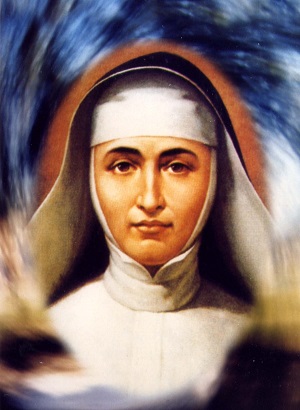
The day of the funeral of sister Agostina the circulation was blocked in Rome. The Messaggero gives the news on 16th November 1894: “never a more impressive spectacle was seen in Rome. From one o’clock in the afternoon the streets close to Santo Spirito and all the roads, from which it was believed that the funeral procession would pass, were crowded with people to the point of making the flow of traffic difficult”. Thousands of people crowded the streets, kneeling before the corpse. “It wasn’t the usual long line of soldiers lined up, the crowd of officials with rare and dazzling colours”, commented the reporter of the Tempo: “it was everybody; it was the Rome of the people; it was the noble, charitable Holy Rome which gave the last salute to the one who, had sacrificed her feelings, thoughts and life and given herself angelically to charity, to the relief of the miserable poor…».
On the hearse the crown of flowers of the Jewish community stood out. On it was written: “To the martyr of charity”. Behind the coffin, there was professor Achille Ballori, Director of the hospital, Deputy Grand Master of the Freemasons, who would also be assassinated in 1914, in the atrium of Palazzo Giustiniani. It was him who warned sister Agostina about that Romanelli, it was him who drafted the death certificate and who performed the autopsy.
Sister Agostina had entered the hospital on August 13, 1887, immediately after having received the religious habit. She was twenty-three years old. Professor Ballori assumed the direction of the hospital three years later. His first act was to expel the 37 male religious who were responsible of the spiritual assistance. They left once and for all in procession, holding the cross singing the Magnificat. The crucifixes and sacred images were removed, the remaining sisters were forbidden to pray in public, to speak of God to the sick, to offer them the religious comforts. It was the Rome of Ernesto Nathan, the years of open and obstinate anti-clericalism. On the door of the ward of tuberculosis patients there was the inscription: “freedom of conscience”. Perhaps sister Agostina did not even understand the meaning of that expression.
She had not received a great education. The second of eleven children, Livia Pietrantoni came from a village, Pozzaglia Sabina, and had obtained only elementary education. It wasn’t because she was not able to study but the family’s economic difficulties had early conducted her away from school, onto the site of the provincial road Orvino-Poggio Moiano which was then under construction. She used to carry, buckets of gravel for a daily pay of fifty cents. There she worked on several occasions, between seven and eleven years and despite this she was able to complete the primary level of studies with good grades.
Her religious education had been that of the catechism and of the few spiritual readings from her grandfather, Domenico … The Rosary, mass, the flowers offered to the Virgin in the chapel of Rifolta, just outside the village. There was also the work within and outside the house, where her father Francesco was forced to stay because of his arthritis and therefore she had to look after the children.

The mountains of the Sabina region
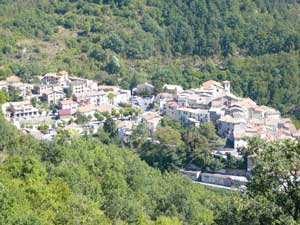
Pozzaglia:
the home village of Livia Pietrantoni
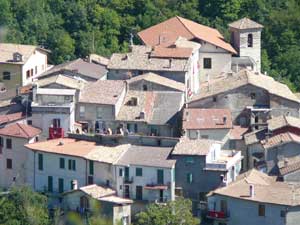
The village of Pozzaglia
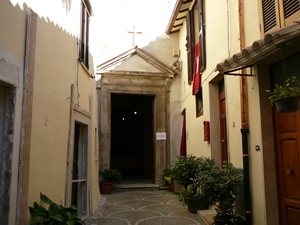
The church entrance
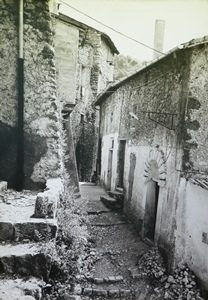
The birth house
She proved to have a strong character, capable of presenting herself to send away an overseer who disturbed her companions on the job and to obtain a reduction of working hours during the month of May that overlapped with the evening function in the parish church.
She also possessed a sweetness that her companions and the boys of her village noticed. An old shepherd declared after her death: “When she came on the mountain to take the milk of her sheep, we felt a strange confusion … our lips were used to pronounce, without difficulty, words and equivocal phrases but, well, in the presence of Livia we couldn’t find the right word immediately.
That blessed daughter made us feel in awe of her and a certain respect that we couldn’t explain’.
Her vocation was almost by chance, with the visit to the country by an uncle, Fr Matthew, who saw her disposition and wrote for her a letter of introduction to the Sisters of Charity of St. Jeanne Antide Thouret. She presented herself awkwardly in Rome, in January 1886, and was rejected. It took the intervention of the parish priest to be accepted even without the “dowry”, that at that time every novice had to bring in the Institute.
The novitiate was not difficult for her as she was used to daily hardships. At the official entrance into religious life, the mistress of novices gave them a short speech: «you are forty, as martyrs of Sebaste; may none of you leave from this number. Maybe some of you would like to imitate them in martyrdom?”.
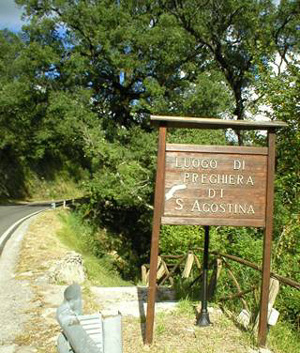
Where Livia prayed
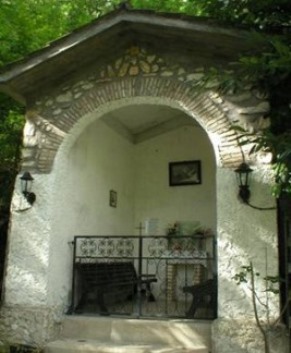
Pozzaglia: the little sanctuary
At first sister Agostina was in the children’s ward, without finding difficulties, since she was accustomed to look after her siblings from childhood. She was soon sent in the adult ward. They were difficult, and sometimes dangerous. The climate, as it is said, was not in favour of the presence of the sisters who often had to endure difficulties, insults, obscenity, obstacles of any kind, and carry out silently their witness.
Dr. Buglioni, employed by the Hospital, has left a memory of her: “Always sweet, she was ready to do not only her duty, but even more and very willingly; quick, humble, hilarious.” The availability to serve exposed her, in 1889 to the contagion of an infectious disease that led her to a closer step to death. During the illness, the sister who assisted her exclaimed: «If sister Agostina heals, we will send her to the tuberculosis ward “. And sister Agostina recovered, at the surprise of the doctors. We have the letter that she wrote to her family: “My dear parents, a few months ago I was seriously ill; I should have died and be taken forever from your affection and tenderness. In what pain you would be today if that had happened! But no, I do not want to grieve you and together with me give praise to God because at present, by the special grace of Mary I am not only healed, but I am healthier than before. Therefore give praise to the good Lord and join me to thank Him for so many graces without deserving them.”
She spent the last five years of her life in the midst of tuberculosis patients. Her silent presence was filled with gestures of charity. An eyewitness recalls that: «in the evening, before retiring, she would approach the bed of the most serious and most dangerous; arranged their pillows and always said a few good words. Sometimes it happened that strange and unhappy patients would be rude to her and would throw on the floor or even at her the plate of food. Even in these cases, sister Agostina did not lose her patience and did not deal severely with them. “
One day, for having seized a knife from a patient, she was attacked and beaten, and the sisters began to fear for her. «We are very exposed, but the Lord protects us» sister Agostina replied “and therefore we must not neglect our duty of charity to escape danger, even if it should cost us our lives … We can expect everything. Jesus was treated thus».
She managed, over time, to hide in a closet an image of the Virgin Mary, who, as she did as a child in the Rifolta Chapel, adorned with flowers and wrote small notes, some of which have been preserved: “Holy Mother”, we read in one of them «you comfort, calm and convert that unhappy one to whom I can’t speak». Some testified that at the bed of the dying, “she played the part of the priest who could not be called. She spent hours and hours without end and the dying appreciated her presence, her words of comfort, peace, and memories of loved ones”.
Even when she contracted tuberculosis, shortly before her death, she asked with insistence the Superior for permission to remain at her post: “Leave me among these patients with tuberculosis! I am accustomed to it. If another were to replace me, she would also contract the disease and so we will be two victims instead of one. The Lord knows what is good for my soul, and if He wants to heal me, He will.”
Joseph Romanelli was a convict, known in Rome as the “Pippo er Ciocco“. The police and the hospital administrators knew of his turbulence and when he was expelled from the ward for his extreme misbehaviour, he threatened to take revenge on sister Agostina who had nothing to do with it. He wrote on a note: “Sister Agostina, you don’t have more than one month of life, you will die killed by my own hands”. On the evening of November 12, 1894 the sisters, worried for her health, had asked her to take some days off. Sister Agostina replied, “We will have rest for such a long time after death that it would be good if we do some standing up while we live!”
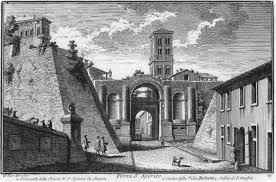
Rome : la porte de l’hôpital du saint Esprit
Icône de sainte Agostina
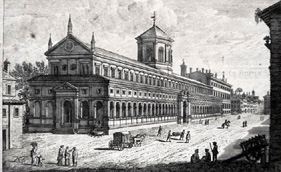
Rome : l’hôpital du Saint-Esprit à Sassia
On the morning of 13 November the killer waited for her in a dark corridor leading to the pantry. He stabbed her three times on the shoulder, the left arm and the jugular, before she could realize what happened. Then, after a scuffle with the only witness at the scene, Romanelli plunged the dagger in her chest. “Mother of mine, help me,” were her last words.
After performing an autopsy, professor Ballori noted that there were no contractions of either nerves or heart that suggested any reaction. He observed that: “Sister Agostina has allowed herself to be slaughtered like a lamb.” At the trial against Romanelli, the Professor himself testified that sister Agostina had never “provoked” the murderer in any way nor infringed the orders prohibiting talking about religion.
In the 20th century there have been many cases of scientifically unexplainable healing due to the intercession of sister Agostina, which led, in the postwar period, to the opening of the cause for beatification and later to the canonization. When Paul VI proclaimed her blessed, on November 12, 1972, he compared her to one of the martyrs much dear to the Roman people: «You know the barbaric story” he said “that crowns her head with a double crown of virgin and martyr. Return to mind the famous words of St. Ambrose in honour of St. Agnes:
“Today is the birthday of a virgin: let us follow her purity. Today is the birthday of a martyr: let us we offer our praise to the Lord.”

